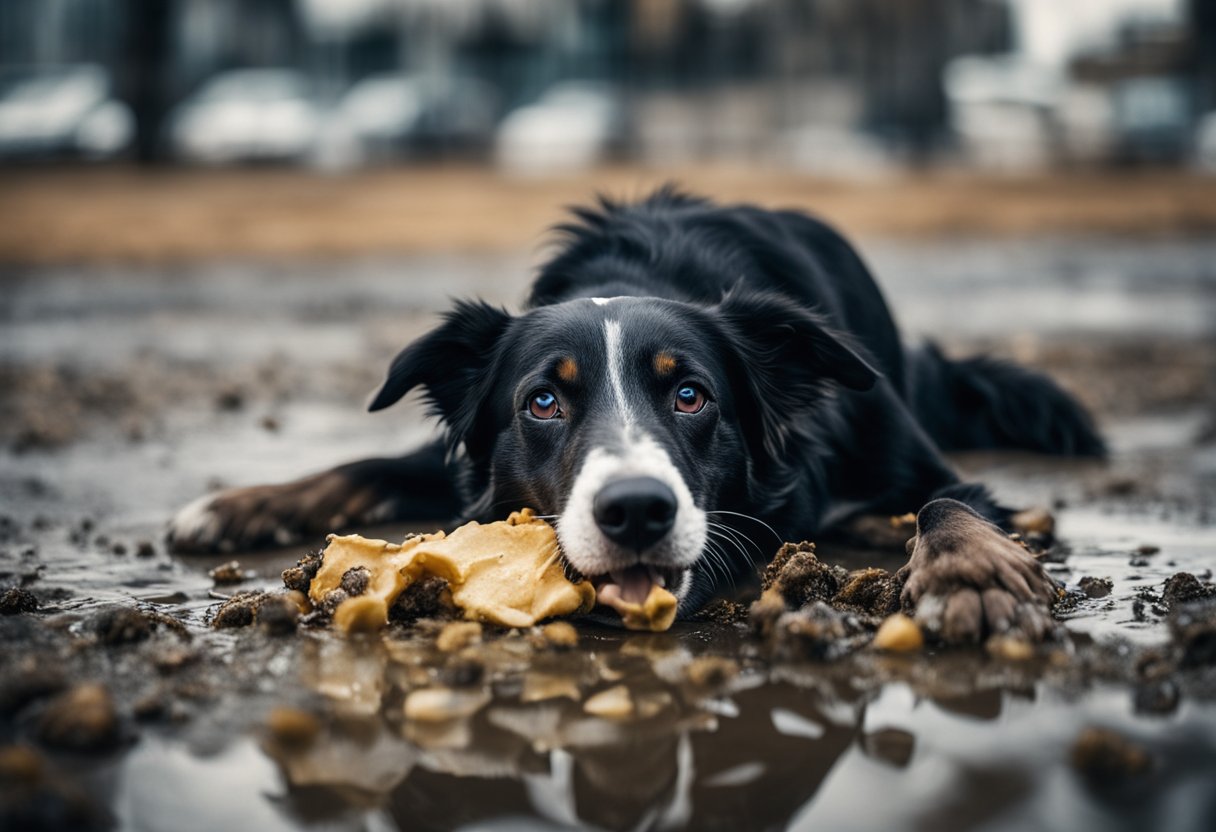Understanding Canine Heat Cycles
Canine heat cycles play a crucial role in the breeding process and have distinct stages and signs. Understanding these can aid in responsible breeding and pet care.

The Four Stages of the Estrus Cycle
The estrus cycle in dogs encompasses four stages: proestrus, estrus, diestrus, and anestrus. Each phase has unique characteristics and a specific duration.
- Proestrus: Lasting approximately 9 days, this phase is marked by the swelling of the vulva and the beginning of bleeding. Female dogs attract, but do not accept, male dogs during this time.
- Estrus: Following proestrus, this stage can last from 3 to 21 days. The vulva remains swollen, the bleeding subsides, and females are receptive to males. It’s during this period that ovulation occurs.
- Diestrus: This phase signifies the end of the heat and lasts about 2 months. If the dog is not pregnant, the signs of heat subside, and she will not entertain the advances of a male.
- Anestrus: A period of inactivity that can range from 4 to 5 months, during which the dog’s body resets in preparation for the next cycle.
Recognizing the Signs of Heat in Dogs
Identifying when a dog is in heat involves observing specific signs. The onset of the first heat cycle typically occurs between 6 to 24 months of age, depending on the breed. Smaller breeds may experience their first heat cycle earlier than larger breeds.
- Physical Changes: Look for changes in the vulva, which becomes swollen and may have a bloody discharge.
- Behavioral Changes: Dogs in heat may exhibit behavioral changes such as restlessness, increased urination, and display a position known as ‘flagging’ to signal to male dogs.
It’s imperative to note that these stages and signs are part of a natural process that affects a dog’s readiness to breed and their interaction with male dogs. Recognizing and understanding these can help owners manage their pet’s health and breeding plans with greater confidence and clarity.
Common Symptoms During Heat

When a dog is in heat, several noticeable behavioral and physical changes may occur, along with possible gastrointestinal symptoms. Owners should be attentive to these changes, as they can impact the overall well-being of their pet.
Behavioral and Physical Changes
Dogs in heat typically exhibit a range of behavioral changes due to hormonal fluctuations. They might become more affectionate or clingy, and some may show signs of stress or anxiety. A common physical sign is a swollen vulva, which is an obvious indicator of a dog being in heat. Additionally, there may be changes in urination patterns, such as more frequent urination or marking.
Appetite changes can occur, with some dogs experiencing an increase or decrease in their food intake. It is not uncommon to observe lethargy; some dogs may seem less energetic or enthusiastic about activities they normally enjoy.
Gastrointestinal Changes in Dogs in Heat
Gastrointestinal issues can manifest during a dog’s heat cycle. Though less common, symptoms like vomiting or diarrhea can be indicative of the stress that the heat cycle imposes on their body. These symptoms might also be linked to more serious conditions, which means that if a pet owner notices persistent gastrointestinal disturbances, they should consult a veterinarian.
Dehydration can result from vomiting or diarrhea, so ensuring the dog has access to clean water is crucial. Persistent vomiting or other signs of illness, such as fever, should be evaluated by a professional, as they can indicate health issues beyond the normal scope of the heat cycle.
Interpreting Vomiting in Dogs in Heat

When a dog is in heat, also known as the estrus cycle, behavioral and physiological changes can lead to various symptoms, including vomiting. Identifying whether a dog is truly vomiting or simply regurgitating food is crucial to understanding the potential underlying cause.
Differentiating Between Vomiting and Regurgitation
Vomiting is an active process where a dog appears nauseated and uses abdominal contractions to expel the contents of the stomach. It is important to observe if the dog vomiting includes bile or undigested food and is often accompanied by abdominal pain and dehydration. On the other hand, regurgitation involves ejecting undigested food from the esophagus typically without abdominal effort, often leading to a more passive expulsion that does not include bile.
Potential Causes of Vomiting
In the context of a dog in heat, stress may cause both acute and chronic vomiting. The estrus cycle can be a taxing period, leading to physiological stress that might manifest as occasional (acute) or persistent (chronic) vomiting.
Other possible causes of vomiting can include:
- Pain: Discomfort from the estrus cycle may trigger vomiting.
- Dehydration: Dogs in heat may become dehydrated due to increased body temperature or decreased water intake.
- Abdominal Pain: Swelling or discomfort in the reproductive organs may lead to vomiting.
Recognizing the signs of vomiting and understanding its potential causes allows for appropriate intervention and care for a dog during its heat cycle.
Health Concerns and Complications

When dogs are in heat, it is critical to monitor their health closely as this period can bring various complications such as infections or exacerbating underlying conditions. Observing any deviations from normal behavior or physical condition is vital for ensuring the well-being of the dog.
Signs of Serious Illness
Dogs in heat can be susceptible to various illnesses, ranging from infections to more severe conditions like cancer or disorders like parvovirus. Symptoms that indicate a potentially serious condition include:
- Abnormal discharge, suggesting possible infection
- Excessive vomiting, which can lead to dehydration
- Unexplained weight loss or gain, which could signal underlying illness
- Fever or abnormal temperature changes
- Clear signs of pain, such as whining or reluctance to move
- Abdominal pain or constipation
- Lethargic behavior or unusual stress
When to Seek Veterinary Assistance
Immediate veterinary care is crucial if a dog exhibits the following symptoms:
- Persistent vomiting or gastrointestinal upset
- Signs of heatstroke, such as excessive panting, drooling, or a temperature above 103°F
- Dehydration, which can be tested by checking if the skin snaps back immediately when pinched
- Refusal to eat or drink for over 24 hours
- Severe lethargy or unresponsiveness
- Difficulty breathing or collapse
It is important for owners to have towels and cool water available to manage fever and stabilize the dog’s temperature while transporting to a veterinarian. Additionally, owners of pregnant dogs need to be acutely aware of these signs, as complications could affect both the mother and her unborn puppies’ health. Dog owners should maintain a close relationship with their veterinarians to navigate the complexities of their pet’s health with certainty and to prevent any diseases from progressing into life-threatening disorders.
Preventive Care and Owner Responsibilities

In managing a dog’s health during its heat cycle, owners are tasked with providing attentive care through dietary adjustments, close supervision, and vigilant health monitoring. These contributions are essential to prevent complications such as dehydration and electrolyte imbalances that can stem from fluctuations in eating behavior during estrus.
Dietary and Lifestyle Management
A dog’s appetite can vary while in heat, necessitating dietary changes to ensure proper nutrition and prevent weight loss. Owners should consult their veterinarian for recommendations on a balanced diet that could include increased fluids and easily digestible foods to support their dog. Introducing smaller, more frequent meals can also help manage shifts in appetite.
Supervising a Dog in Heat
Supervision is critical to protect a dog from the stress of unwanted attention and to monitor for signs of distress or illness. Dogs in heat may exhibit behavioral changes such as restlessness or agitation. Keeping them calm and comfortable minimizes risks and helps owners detect any unusual symptoms requiring veterinary attention.
Regular Veterinary Check-Ups
Scheduled veterinary care is paramount during a dog’s heat cycle. Veterinarians can perform ultrasounds, x-rays, or biopsies if necessary to ensure the canine’s reproductive health. They can also address any complications from dietary changes or potential electrolyte imbalances. Regular check-ups maintain a proactive approach to a dog’s well-being during this sensitive period.
Understanding and Responding to Heat-Related Illnesses
When dogs experience heat-related illnesses such as heat exhaustion or heat stroke, they may exhibit symptoms like vomiting, dehydration, and lethargy. It’s imperative to recognize these signs and understand how to respond promptly to prevent serious complications.
Heat Exhaustion and Heat Stroke in Dogs
Heat exhaustion in dogs can occur when they are exposed to high temperatures and their bodies are unable to cool down effectively. This can quickly escalate to heat stroke, which is a severe and potentially life-threatening condition. Signs of overheating in dogs include:
- Excessive panting or difficulty breathing
- Increased heart rate
- Drooling, weakness, or collapse
- Bright red or pale gums
- Vomiting or diarrhea
If a dog’s temperature rises above 103°F (39.4°C), it indicates fever or potential heat exhaustion. At temperatures above 106°F (41.1°C), the risk of heat stroke becomes significant. Immediate measures to cool the dog down are critical and may include moving them to a shaded area, providing water if they can drink, and using cool water to dampen their coat.
Gastrointestinal Issues Due to Overheating
Overheating in dogs can lead to gastrointestinal issues such as vomiting, which is the body’s way of coping with stress and can be a direct result of thermal regulation failure. Along with vomiting, a dog may experience signs such as:
- Diarrhea
- Loss of appetite or refusal to drink water
- Abdominal pain
These symptoms can further lead to dehydration and exacerbate the effects of overheating. It’s important to treat overheated dogs by offering small amounts of water and avoiding ice cold water, which can cause shock. In severe cases, immediate veterinary intervention is necessary to administer fluids and prevent further damage from the heat stress.
Frequently Asked Questions
Understanding a female dog’s heat cycle is crucial for the health and well-being of the pet. This section addresses some of the most common concerns pet owners have regarding symptoms, behavioral changes, and appropriate responses during a dog’s estrus cycle.
What are common symptoms of a female dog during estrus?
A female dog in estrus may exhibit signs such as a swollen vulva, bloody discharge, frequent urination, and behavioral changes, including restlessness or increased affection.
Can changes in a dog’s menstrual cycle lead to gastrointestinal issues?
Hormonal fluctuations during a dog’s heat cycle can potentially lead to mild gastrointestinal upset, but persistent vomiting or diarrhea warrants a veterinary consultation.
What should I do if my female dog starts vomiting during her heat cycle?
If a female dog begins vomiting during her heat, monitor her closely. Occasional vomiting may occur, but if it persists or is accompanied by other symptoms, seek veterinary advice, as this may indicate an underlying condition.
How can I distinguish between normal heat behavior and signs of illness like pyometra?
Normal heat behavior includes manageable behavioral changes and minimal discomfort. If a dog exhibits severe lethargy, loss of appetite, excessive vulvar discharge, or an enlarged abdomen, these could be signs of pyometra, a serious uterine infection, and veterinary care is urgent.
Are male dogs affected behaviorally or physically by a nearby female in heat?
Male dogs may display increased restlessness, roaming, marking, or mounting behaviors when they sense a nearby female in heat, but there are typically no direct physical effects on them.
Does a heat cycle typically cause changes in a dog’s defecation patterns?
While a heat cycle itself does not typically affect a dog’s defecation patterns, the stress associated with estrus can sometimes cause temporary digestive disturbances, such as mild constipation or diarrhea.
